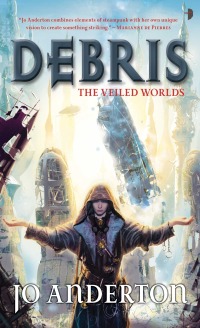Debris by Jo Anderton
 Thursday, November 3, 2011 at 11:24PM
Thursday, November 3, 2011 at 11:24PM 
Published by Angry Robot on September 27, 2011
Tanyana Vladha is an exceptionally skilled pion-binder. Pions are friendly, sparkly, playful subatomic particles -- except for the red ones, which are angry and nasty. Pions can be manipulated for all sorts of constructive purpose, and their manipulation is the task of a pion-binder. Tanyana is using pions to build a massive statute when she's attacked by red pions. The attack destroys her ability to manipulate (or even to see) pions, but gives her the ability to see the debris that pions leave in their wake -- an ability that the governing authority (veche) uses to define her new (and low status) role in life: debris collector. She must win the trust of her collection team and adjust to her new life -- and new powers -- while trying to find the persons responsible for her downfall.
The plot is an intriguing mix of mystery and action; I was never certain quite where the story would take me. It's also strange. To an extent, the strangeness is compelling, yet by the end the story's oddity borders on fantasy. The world Anderton describes is so unfamiliar that I found it difficult to relate to (or care about) the threat that Tanyana battles. I was more interested in the relationships between the characters, the evolving loyalties and inevitable betrayals. The characters are interesting, particularly a debris collector named Lad, who seems to be a bit simple-minded but turns out to be gifted in ways that most people can't recognize.
Debris is, in a sense, a novel about class conflict. The veche and their moneyed friends oppress those who don't have the gift of pion-binding. Some descriptions of disparity between the decrepit poor and the snobbish rich echo Dickens.
There are times when the pace drags, as if Anderton felt the need to prolong the suspense (and given that this is the first novel of a trilogy, perhaps she did). For the most part, however, the story zips along to a satisfying conclusion -- although not a conclusion that resolves all the unanswered questions. I'm not sure I'll seek the answers to those questions in the next installment of the trilogy, but I have no regrets about reading this one.
RECOMMENDED



